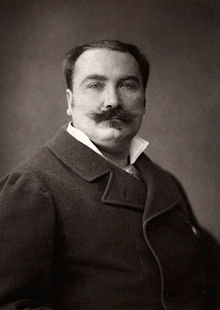Étienne Prosper Berne-Bellecour
Étienne Prosper Berne-Bellecour (born June 29, 1838 in Boulogne-sur-Mer , † November 29, 1910 in Paris ) was a French painter , etcher and illustrator . During the Third Republic , the artist was one of the most successful military painters in France.
life and work
Born in Boulogne-sur-Mer, Berne-Bellecour spent his youth in Calais , Brussels and Marseille . He began his artistic training in Paris in the studio of the painter Émile Signol (1804-1892). In 1859 he applied in vain for the Prix de Rome and the associated scholarship and the opportunity to study in Rome. At the École des Beaux-Arts he continued his studies with François Picot and met the painters Alphonse de Neuville and Félix Barrias in his studio .
Berne-Bellecour first exhibited at the Salon de Paris in 1861 . His painting Souvenirs de Normandie , shown there, is one of the typical landscape paintings that the artist created in the 1860s. In addition, Berne-Bellecour worked on some portraits. After his first salon success in 1868 with Grande Chaleur , he received a medal award in 1869 for Désarçonné , a painting that can be assigned to genre painting. Since the late 1860s, hunting scenes and military motifs can increasingly be found in his work.
Together with his brother-in-law, the painter Jean-Georges Vibert , as well as the artists Jean Baptiste Édouard Detaille and Alexandre-Louis Leloir (1843-1884), Berne-Bellecour undertook a study trip to Algeria in 1870 , which the group broke off after the beginning of the Franco-Prussian War to return to Paris. Berne-Bellecour joined the Franc-tireurs and received a military award for his services in the fighting on Mont Valérien .
The experiences and impressions of the war had a lasting impact on the artist's work. Together with Jean Baptiste Edouard Detaille and Alphonse de Neuville, he visited the scenes of the last war every year, where he conducted studies for his works. His military-themed paintings met with great interest from the public and buyers of his paintings often included high-ranking French officers. The motifs mostly show scenes from everyday army life, maneuvers or the simple life of soldiers. With great attention to detail, he devoted himself to depicting the uniforms and equipment.
Together with Jean-Georges Vibert, Berne-Bellecour wrote the comedy Tribune mécanique , which premiered in 1872 at the Théâtre du Palais-Royal . Until 1905 he exhibited regularly in the Salon de Paris and received several awards there. In 1878 some of his works were included in the official selection of French painting at the World Exhibition in Paris. In the same year he was appointed Knight of the Legion of Honor .
After his oil paintings he produced numerous prints, some of which were published in contemporary illustrated newspapers. In addition, Berne-Bellecour created some etchings that were influenced by his friend Jules-Ferdinand Jacquemart . Together with other military painters, he designed some motifs to illustrate the books Le Premier Grenadier de France and La Tour d'Auvergne by Paul Déroulède and for En campagne by Jules Richard (1825–1899).
In his old age, Berne-Bellecour lived in the Chateau d'Egreville in the Seine-et-Marne department . His students included the painters Eugène Berthelon (1829–1914), Marie-Désiré Bourgoin (1839–1912) and Jean-Jacques Berne-Bellecour (1874–1939), one of the artist's sons. The latter also specialized in military motifs, which is why there was often confusion in the attribution of the works of both painters.
Works in public collections
- Tirailleurs de la Seine au combat de Malmaison , 1874 - Versailles , Musée national du château et des Trianons
- Zouave à la fontaine - Rennes , Musée des Beaux-Arts
- The Lover - New York , Brooklyn Museum
- Colonel of cavalry and artillery major on maneuvers - Dublin , National Gallery of Ireland
- Prisonniers allemands - Mulhouse , Musée des Beaux-Arts
- Chasseur à pied en faction - Mulhouse , Musée des Beaux-Arts
gallery
literature
- Christopher Forbes, Margaret Kelly: War à la mode, military pictures by Meissonier, Detaille, de Neuville, and Berne-Bellecour from the Forbes Magazine collection . Forbes Magazine, New York 1975.
- General Artist Lexicon Volume IX, 1994, page 572.
Web links
| personal data | |
|---|---|
| SURNAME | Berne-Bellecour, Étienne Prosper |
| BRIEF DESCRIPTION | French painter, etcher and illustrator |
| DATE OF BIRTH | June 29, 1838 |
| PLACE OF BIRTH | Boulogne-sur-Mer |
| DATE OF DEATH | November 29, 1910 |
| Place of death | Paris |





